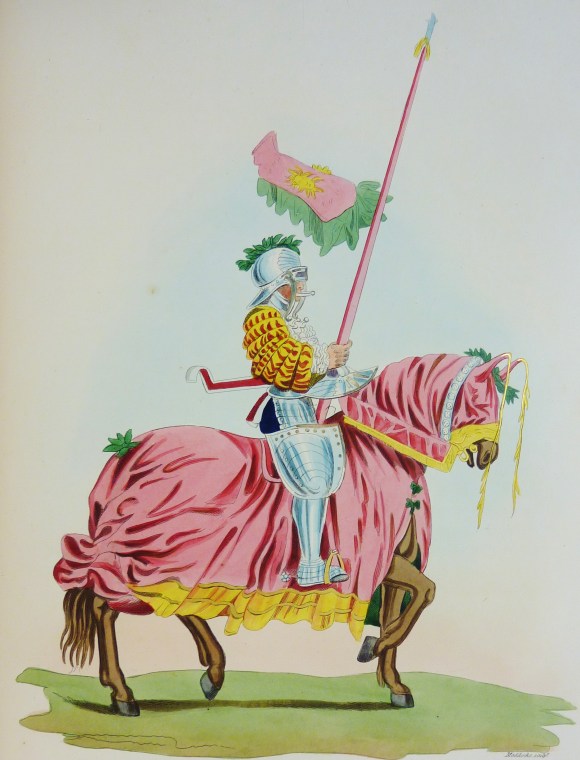This month’s Item of Interest post comes from Ken Gibb (Rare Books Librarian), who is delving into the work of Sir Samuel Rush Meyrick .
A critical enquiry into ancient armour is the greatest work of Sir Samuel Rush Meyrick (1773-1848), a prolific collector of arms and armour. Meyrick inherited a passion for collecting from his father John, an officer in the Honourable Artillery Company and a Fellow of the Society of Antiquaries. In the 1820s Samuel began to build up a considerable collection of arms which he arranged in his home in Upper Cadogan Place, London, and welcomed a number of important visitors, including King George IV.

Meyrick published numerous important texts on arms and armour, including a catalogue of his own collections, however it was Sir Walter Scott who suggested that he make drawings of the best pieces he owned. Meyrick’s drawings were then engraved by Joseph Skelton and Samuel wrote detailed descriptions. Meyrick’s magnum opus, A critical enquiry into antient armour as it existed in Europe, but particularly in England, from the Norman conquest to the reign of King Charles II, with a glossary of military terms of the middle ages, to give its full title, was initially released in parts from 1824, but was published in 1830 as a three volume set lavishly illustrated in colour and gilt with Meyrick’s drawings. We hold a copy of this set in the Sion College collection within Lambeth Palace Library [B99/1M57].

With the publication of this book Samuel solidified his reputation as an authority in the study of armour and was able to rectify some historical inaccuracies that found their way to the displays of armour in the Tower of London and other collections (in 1832, Meyrick himself would be knighted for reorganising the collections at the Tower and at Windsor). The Edinburgh Review said of the new displays that “while we have the very knights in their proper armour, surcoats, etc. before us, blazing in gold and silver, we feel as if the age of chivalry, if once gone, had returned in its glory, and we are transported back to the sentiments as well as the scenes which it inspired.”
By this time Meyrick’s collection had far outgrown its home in London and Samuel felt that it now deserved to be housed in an appropriately grand venue. Having failed to acquire Goodrich Castle in Herefordshire, he hired Gothic Revival architect Edward Blore to design Goodrich Court. Blore had also been responsible for the redesign of Lambeth Palace during the 1820s. The enormous armoury was built to house the most spectacular of Meyrick’s pieces in a suitably impressive setting filled with natural light.

On Meyrick’s death in 1848 his cousin Augustine inherited both Goodrich Court and the armour collection. After the collection had been displayed at the South Kensington Museum (now the V&A), the finest items were sold at auction in 1869, many of them to Frederic Spritzer, a French dealer. These were later purchased by Sir Richard Wallace and now form part of the Wallace Collection at Hertford House, Westminster.

References:
“Dr Meyrick on ancient armour”, Edinburgh review. (Jan. 1824). 39, 5, pp. 346-363.
Meyrick, Samuel Rush (1830?). A critical inquiry into antient armour. London: Dowding.
Roscoe, T. and Meredith, C. (1844). Wanderings and excursions in South Wales with the scenery of the River Wye. London: Longman.
Samuel Rush Meyrick (2017). https://en.wikipedia.org/wiki/Samuel_Rush_Meyrick




